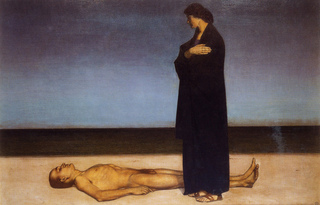The Munich Secession and America at the Frye
By Jason McBride
January 31, 2009
Formed in 1893 in defiance of the Künstlergenossenschaft, the dominant arts institution in late nineteenth century Munich, the Secession nurtured more progressive strains in art. Its founders, which included Franz von Stuck, Fritz von Uhde, and Hugo von Habermann, went beyond painting to design buildings and furniture, encouraging decorative art. Breaking the convention of crowding paintings together at exhibitions, the Secessionists allowed their works to breathe on lightly-colored walls, a practice we take for granted today.
The Secessionists held their first American show at New York's Metropolitan Museum of Art in January of 1909 and followed with a Chicago show in April. The Frye follows history, running its show from January 24 through April 12.
Curated by Jo-Anne Birnie Danzker, former director of Munich's Museum Villa Stuck, this show is an attempt by the Frye to reexamine its private collections. While many of the works come from German museums, about half belong to the Frye.
"This exhibition is really the culmination of work in the last four years to re-contextualize the collection," said Robin Held, the Frye's chief curator.
According to Held, Frye staff and board members had to break with a longstanding"will and culture" at the museum that didn't allow its collections to be mixed together or with outside works.
Every painting in the Künstlergenossenschaft section of the exhibition belongs to the Frye. Without that contrast, the remaining Munich Secession works would lose their historical value. The movement is more than a hundred years old, so its output is conservative by today's standards. By giving us the crotchety stuff of the time, we can see how radical the Secession was.
And radical it was. Co-founder Stuck pressed all the standard buttons by mixing religion with sensuality in his painting "Sin." "Sin," which comes with a columned gold frame by Stuck, depicts a shadowy woman, wrapped in a snake, beckoning from the darkness. A nod to the Garden of Eden temptation myth, the woman would seem to be Eve, and a very sexy Eve at that. The title and style suggest evil, but there's no escaping its forbidden allure.
Compare this to Franz von Lenbach, one of the Künstlergenossenschaft's preferred artists. He painted beautiful female portraits, but his style, with its sober lighting and Turner-like brushstrokes, seems old fashioned compared to Secessionist figures. Even the exultantly sensual"Voluptas," a healthy, nude woman in an ecstatic pose, painted four years after the first Secessionist exhibition, doesn't come close to the blunt carnality of Stuck's "Sin."
But this exhibition is not a contest. There is just as must brilliance in both collectives, and the Frye captures the best of both. Several years after the Secession's first exhibition, it held a joint show with the Künstlergenossenschaft. The Frye delivers an apt commemoration of excellent art that deserves to be seen together.


